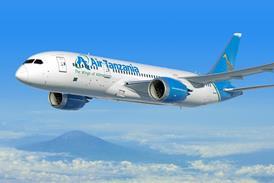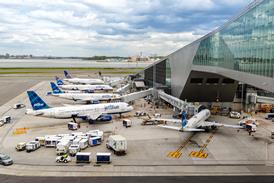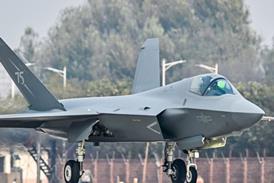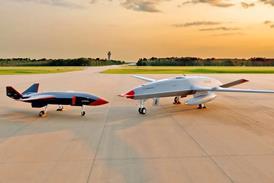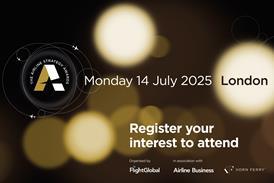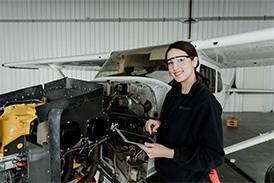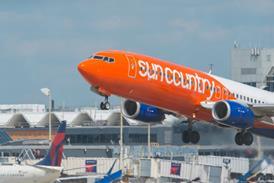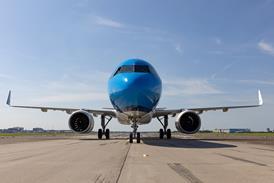While there has been no shortage of advocates championing the potential for hydrogen-powered aircraft, the scale of the challenges that need to be overcome has always made the likelihood of the fuel significantly contributing to the aviation industry’s decarbonisation efforts a long-term ambition.
For all its potential, introducing a new fuel source to the industry – and one whose properties require major changes in infrastructure both in the air and on the ground at the airport and beyond – is a huge undertaking, even before the requirement for a wider green hydrogen ecosystem is considered. This is further complicated by hydrogen also being central to the scaling up of power-to-liquid synthetic sustainable aviation fuel (SAF) – the linchpin of aviation’s plan to reach net-zero carbon emissions by 2050.
Progress tackling the technical challenges has been made, but the collapse of Universal Hydrogen, and then Airbus pushing back its ambitions for when a hydrogen-powered single-aisle aircraft could enter service, illustrate just how long-term an ambition it may be. Notably, both developments were driven by commercial factors as much as by technology challenges.

Propulsion developer Universal Hydrogen was one of the most advanced operators in the space. The California-based company had been developing hydrogen fuel cell propulsion conversions for both De Havilland Canada Dash 8s and ATR turboprops, and carried out a landmark partly hydrogen fuel cell-powered Dash 8 flight in March 2023. However, it pulled the plug on further work and closed down in June 2024 after it failed to secure fresh funding.
Then there is the recognition from Airbus that a clean-sheet hydrogen-powered aircraft will be at least five years later in coming than it had first hoped.
While Boeing has been more lukewarm to hydrogen-powered propulsion, Airbus has championed its potential – and five years ago set pulses racing with a possible 2035 service entry timeframe for such an aircraft in unveiling its ZEROe concept of hydrogen-powered aircraft.
“As you know, it is a very personal conviction that formed along the years that hydrogen has a role to play and is an energy of the future,” said Airbus chief executive Guillaume Faury during the Airbus Summit in March.
However, he confirms that while the airframer has established the feasibility of a commercial airliner powered by hydrogen, such an aircraft would not be competitive under current conditions.
“To some extent we have come to the conclusion that we would be wrong to be right too early,” Faury says. But he stresses: “We continue to believe in hydrogen. We are absolutely convinced that this is an energy for the future for aviation. But there is just more work to be done.”

Airbus had initially unveiled three potential concepts within ZEROe; a 2,000nm (3,700km)-range blended-wing-body aircraft capable of carrying 200 passengers; a more conventional-looking airliner powered by hydrogen-burning gas turbine engines; and a 100-seat regional aircraft with hydrogen fuel gas turbines.
It is now focusing on a fuel cell-powered airliner that could carry up to 100 passengers on routes of up to 1,000nm, highlighting the wider benefits of being able to deliver a “fully electric” aircraft.
While it has not given a specific new timeframe, Airbus executives flag the five- to 10-year delay in the ecosystem required to support hydrogen operations. “This is about hydrogen at airports. It is about the quantity of hydrogen, it is about the quality, the price of it, the infrastructure, the regulation of it,” says Airbus head of future programmes Bruno Fichefeux.
“We have a fairly good view of how this ecosystem is evolving and the conclusion is shared by many industrial players and energy providers: we are lagging behind five to 10 years to the volume and the prices that we would need to make an economically competitive aircraft on the market.”
Airbus is not alone in reaching such conclusions. Embraer, for example, has been studying possible development of a hydrogen fuel cell-powered aircraft, and other low-emission types, under its Energia project, which it first revealed in 2021. Last November, the Brazilian company’s vice-president of engineering and technology development, Luis Carlos Affonso, said the technical hurdles will require more time to overcome.
“These technologies have proven to be tougher than previously expected,” he said during an Embraer investor day. “Batteries have not evolved as quickly as previously thought, the same with hydrogen. So it may delay a bit the appearance – with the exception of very short-range.”
WIDER ECONOMY
Crucially, the use of hydrogen as a fuel source within the sector is dependent on the development of the wider hydrogen economy.
Bram Peerlings, programme lead climate-neutral aviation at Dutch applied research centre Royal Netherlands Aerospace Centre (NLR), says: “If there is a hydrogen economy starting up, aviation could also tap into that. But if that hydrogen economy isn’t launching, then aviation is by itself much too small to kickstart that.
“In that sense, if the general appetite and interest in hydrogen reduces, then that quite quickly gets reflected in the aviation outlooks as well, separate from any aviation-specific challenges.”
NLR has a specialism in aviation sustainability, and together with SEO Amsterdam Economics, prepared the recently-revised Destination 2050 roadmap report for European aviation trade bodies. The report, commissioned by airports body ACI Europe, Airlines For Europe, aerospace and defence body ASD, navigation association CANSO and the European Regions Airlines association, updates a previous pathway to decarbonisation for European aviation from 2021.
In that regard it provides an insight into the direction of travel of various technologies, and hydrogen power – at least in terms of its contribution to helping the industry to reach net-zero carbon emissions by 2050 – is now seen as having a reduced role.
The updated report estimates the contribution of hydrogen-powered aircraft and the switch to hydrogen as a fuel would account for around 6% of the required emission savings. By contrast, that had been foreseen as accounting for a fifth of savings in the first roadmap published four years earlier.

Peerlings, who led NLR research on the report, points to three main reasons for the smaller contribution of hydrogen.
“First of all, we’ve now modelled the single-aisle aircraft to only enter service by 2040. Ultimately, Destination 2050 looks at the impact by 2050. So if you introduce something in 2035, it has 15 years to penetrate into the fleet. If that is five years less because of the later entry into service, that already has quite a substantial impact at least by the year 2050.”
Another key change in the modelling comes from reduced assumptions about the market share that hydrogen aircraft will take. The model in the first roadmap document assumed that hydrogen-powered aircraft would be deployed wherever possible on intra-European routes of under 1,080nm. The assumption is now that such aircraft will ultimately take a 50% share on these routes.
“We assume that on the routes that could theoretically be served by hydrogen-powered aircraft there will also be a share of aircraft running on conventional aviation fuel or drop-in sustainable aviation fuels to serve part of that market,” Peerlings says.
He also points to smaller, but still notable, impacts highlighted in research around fuel cell efficiency and fuel tank weight published since the first report. This suggests a lower energy efficiency improvement for hydrogen-powered aircraft compared to hydrocarbon or SAF-powered single-aisles.
ONGOING RESEARCH
Continued research and ongoing development work will further shape the role of hydrogen.
“The studies that are currently being done will hopefully provide a lot of insight into where hydrogen is in the future, by when and what we can expect from it,” Peerlings says. “I would also like to know today rather than tomorrow. But we simply have to accept that we have to wait a bit longer.”
Airlines enthusiastic about hydrogen have also tempered their expectations. For example, Central European budget carrier Wizz Air in 2022 signed an agreement with Airbus to explore the potential for hydrogen-powered aircraft operations. That initiative aimed to provide the carrier with a “deeper understanding” of how such aircraft could change its business model. However, the airline’s recently published net-zero roadmap is anchored on SAF – contributing to over half of the emissions savings – as well as aircraft technology and air traffic management modernisation.
The strategy builds on its move in April 2024 to commit to reaching 10% SAF usage by 2030, itself in part driven by the start of SAF mandates in Europe. Speaking at the time, Wizz Air corporate and ESG officer Yvonne Moynihan highlighted the slow pace of infrastructure development to support hydrogen-powered aircraft and the carrier’s requirement for higher-capacity models than 100-seaters.
UK carrier EasyJet has also been a vocal advocate for hydrogen power. Its then-chief executive Johan Lundgren in 2023 indicated its desire to be a launch customer for the ZEROe jet and has been collaborating on several projects, including working with Rolls-Royce on hydrogen combustion testing.
“We are keen on any next-generation aircraft that comes along,” says new EasyJet chief executive Kenton Jarvis. “Hydrogen is probably the only technology, if it comes through, that is truly carbon neutral. It’s a true opportunity to have carbon-free flying.”
On a global basis, airline association IATA has historically given less weight to the emergence of hydrogen propulsion and other new technologies in reaching net-zero by 2050, emphasising SAF as the primary means for the sector to decarbonise.
IATA’s detailed net-zero roadmap published last September sees hydrogen power contributing around 5% to the sector’s required emissions reduction by 2050. As such, the association sees a bigger role for renewable hydrogen in supporting the scaling of SAF production.
Airbus pushing back its timeframe may cause ripple effects down the chain. For example, GKN Aerospace is reviewing the scale and timing of its hydrogen research and technology investments, given the ZEROe aircraft was a likely platform for its developmental fuel cell powertrain or hydrogen storage system.
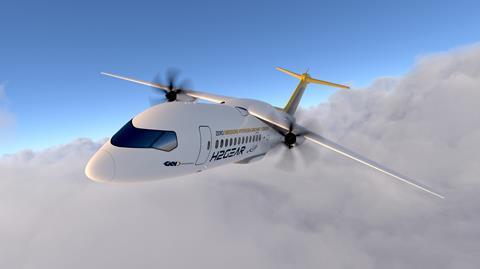
“The change is meaningful – it’s not just a year or two shift, it’s a meaningful shift,” says GKN Aerospace chief technology officer Russ Dunn. “So, we are now looking at our total portfolio to decide which of those ingredients we should retain, which of those ingredients we should slow down or even put on the shelf.”
GKN is actively engaged in multiple collaborative projects aimed at developing a comprehensive zero-emission hydrogen-electric propulsion system. That includes leading the UK-funded H2GEAR programme, which aims to develop a hydrogen propulsion system for sub-regional aircraft. GKN aims to validate the performance of a cryogenically cooled 1MW fuel cell powertrain in 2026.
That is just one of a string of developments and technology initiatives looking at hydrogen power aspects under way across the sector.
NLR, for example, is involved in several projects that are part of the Netherlands’ Luchtvaart in Transitie (Aviation in Transition) programme, including an initiative to develop a liquid hydrogen-powered range extender for a Pipistrel Velis Electro light aircraft. It is targeting a demonstration flight in 2026.
FEASIBILITY TESTS
Elsewhere, Pratt & Whitney in January reported growing confidence over the potential for a revolutionary hydrogen-combustion, steam-injection turbine engine in the 2050s under its Hydrogen, Steam-Injected, Intercooled Turbine Engine concept, after component-level testing of the “hardest parts” of the powerplant demonstrated the feasibility of the architecture.
However, perhaps the nearest term hopes lie with ZeroAvia. The UK-US firm is developing its ZA600 hydrogen-electric powertrain, designed for up to 20-seat commercial aircraft, as well as the ZA2000, which will support up to 80-seat regional turboprops. It has conducted test flights of the ZA600 on a modified Dornier 228 from early 2023 until April 2024.

The company is now focusing on certification efforts, which will see the 600kW electric propulsion system (EPS) – part of its other overall powertrain – certified separately by the US Federal Aviation Authority (FAA) from the wider ZA600 powertrain.
That process was boosted earlier this year when ZeroAvia reached agreement with the FAA on the certification basis for the EPS, which it will also sell on a standalone basis for new electric air transport applications. In February, it disclosed its first standalone EPS sale with a deal to California-based Jetcruzer International for its 500E.
Work continues on certification of the overall ZA600 powertrain by the UK Civil Aviation Authority. This is targeted for completion in 2026, with service entry expected to follow later that year or in 2027, with Cessna Caravan operator RVL Aviation signing as launch customer.
Additional reporting by Dominic Perry

